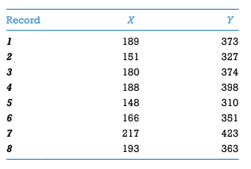Find the correlation coefficient for the following data, and give the significance:

The correlation coefficient is calculated as follows:
r = (sum{i=1 to n} (xi - xbar)(yi - ybar)) / (n-1)sxsy
Thus
r = (sum{i=1 to n} (xi - 179.0)(yi - 364.9)) / (7 * 23.1 * 36.4)
This gives us r = 0.937. Thus, t = r * sqrt(n - 2) / sqrt(1 - r2
) gives us the significance as follows:
t = r * sqrt(n - 2) / sqrt(1 - r2
)
t = 0.937 * sqrt(8 - 2) / sqrt(1 - 0.9372
) = 6.570
For a n - 2 = 6 df 2-tailed t distribution, p is less than .0025.
You might also like to view...
Analysis of variance (ANOVA) for between-subjects designs operates on the concept of
A) correlation. B) matched pairs. C) comparing the error variance to the variability within-groups. D) comparing the variability of the means against a standard based on the variability of the scores within each group.
Which is NOT true of India's federal system?
a. There are four legislative lists of powers. b. The central government, state governments, and provincial governments share power. c. In times of emergency, the seat of government can convert the federal system into a unitary one. d. The sharing of powers across multiple levels is designed to ensure stability. e. While the states have some reserved powers, the federal government holds supremacy in certain matters.
Texas cities receive approximately one-fourth of their annual operating budget from state appropriations
Indicate whether this statement is true or false.
Discuss the features of the Energy Policy Act of 2005.
What will be an ideal response?